
A glorious late spring day in 2024, one to anticipate sumer is acumin in, luhde sing cuc-cu, wrong on both counts (at least so far – I’m writing in mid-July – not much summer yet, and I’ve not heard a cuckoo in many years). I was in the Mendips with Kevin and George. I sat on a tussock and thought of an old paperback, “Come Out with Me”, written by Lewis Wilshire, which once sent me roaming the countryside round Bristol & Bath.
The physical book was buried so deep in my “stuff mountain” that it took me the next few weeks to find it. I discovered that another previous me had ruined the cover by putting a sticker on it with the words……
…..“I spent many happy hours walking (alone) with this little book, usually Sundays. Aged about 16-18. Buses great then!!”
Only I couldn’t have been 16. It was published seventy years ago in 1954 when I was seventeen.
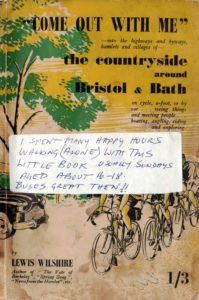 The book cost me the huge sum of one shilling and thre’pence, – nobody ever said, “three pence”- made up by fifteen old large pennies, which was “a bob” (or “two tanners”) plus “a thre’p’ny bit”. Apart from “quid”, which survives by the skin of its base metal, the world is that much bleaker for the loss of these lovely old names. Who now remembers “half a knicker”? (Ten bob, obvious.) I only earned £2.7s 6d a week to start, most of which went to Mum and Dad for my “keep”, so you can work out for yourself that 1/3d was not to be sneezed at. For Monday to Friday and a half-day on Saturday I was a caged mustang, snorting and kicking for real, chained up inside the likes of Wick Ochre Works or British Paints Ltd with several other hell-holes in between. I was like the bloke you see memorialised on park benches: I hated these places and everybody in them. An open road at weekends was my hope. Why alone? There were plenty who said, “I’d love to do that, I’ll come with you next Sunday,” but when the time came, they found other more exciting things, boyfriends, had to help their mother to make the dinner, even chapel. So, fed up with this, I went by myself.
The book cost me the huge sum of one shilling and thre’pence, – nobody ever said, “three pence”- made up by fifteen old large pennies, which was “a bob” (or “two tanners”) plus “a thre’p’ny bit”. Apart from “quid”, which survives by the skin of its base metal, the world is that much bleaker for the loss of these lovely old names. Who now remembers “half a knicker”? (Ten bob, obvious.) I only earned £2.7s 6d a week to start, most of which went to Mum and Dad for my “keep”, so you can work out for yourself that 1/3d was not to be sneezed at. For Monday to Friday and a half-day on Saturday I was a caged mustang, snorting and kicking for real, chained up inside the likes of Wick Ochre Works or British Paints Ltd with several other hell-holes in between. I was like the bloke you see memorialised on park benches: I hated these places and everybody in them. An open road at weekends was my hope. Why alone? There were plenty who said, “I’d love to do that, I’ll come with you next Sunday,” but when the time came, they found other more exciting things, boyfriends, had to help their mother to make the dinner, even chapel. So, fed up with this, I went by myself.
I took sandwiches, a bottle of water, the book and bought a bus ticket. These days, I find it hard to believe, that I got to the likes of Blagdon from Kingswood, (on Sundays!) with no X line, no bus station…but a timetable and better service. The single-deckers from Anchor Road meandered along the Somerset lanes to Priddy, Wookey, or Chew Valley. The walk called “Severn Shore” though often muddy, you can’t have everything, was even more accessible, – steam train, no corridor, from Lawrence Hill. Remember “The Blue Lagoon” at Severn Beach? The Avon Valley, easier still, was only “down ‘Annum”, so I could walk there from Blackhorse Road. How do I remember? Because I ticked them off. I stayed out all day. Lewis Wilshire was an amusing companion with a fine turn of phrase. Nempnett Thrubwell was like “the first primroses of spring!” he said. The stones of Stanton Drew were “arthritic old men.” He peppers his narrative with anecdotes of ghostly monks; of Princess Caraboo, the impostor; Dicky Pearce, household jester to the Earl of Suffolk; Cheddar Man; Augustus Toplady, the Calvinist preacher who wrote “Rock of Ages” after sheltering from thunder and lightning in a cleft at Burrington Combe, (so say); Joe Plumley, a quarryman, killed in a cave, which Lewis called “Plumley’s Den” but is more widely known as “Plumley’s Hole”. He got the year wrong too, not 1874, unless poor Joe had a long wait in the dark until taken out and re-entombed on 10 January 1875 at Burrington. Unfortunately, the Burial Register is silent on the cause of Joe’s sad end, though for the connoisseur, (“Thee dost wanta know everything” a refrain which punctuated my youth) see Proceedings of Bristol University Speliological Society, 1994.[1]

Lewis recounted his own tales or met the raconteurs on his travels. I have no recollection of meeting a single soul.
The focus of our day out in 2024 was a mound at Ubley Warren near Charterhouse.

It looks a bit rugged, but hardly K2. Kevin considered it would make a benign stroll for his parents, now rather decrepit and decayed gentlefolk.
The me of 1954 would have galloped up the bit of a slope. Seventy years on, it was a different story. Kevin’s plan was to take us up to a copse, splendid for birdwatching. At the start he insisted I squint through his fancy field glasses, but I could not focus my one good eye on the buzzard which he excitedly pointed out.
“Oh, me ankle’s gone!” I cried out in anguish after only another few yards.
This troublesome joint folds up under me, without previous convictions. “There’s nowhere to sit,” I wailed.
“I should have brought fold-up chairs,” the Kev said patiently, no doubt his thought bubble wondering why he had lumbered himself with this old crock.
Unable to find a rock without a jagged top, I squatted down on the tussock, whilst the young ornithologist and his Dad (with multiple infirmities of his own, age being the least of it) continued intrepidly upwards in the true Bulldog Spirit. Sadly, they never made the copse but watched from a stile, which George could not negotiate, for green woodpeckers or whatever feathered friend was available. I was following their progress from my perch below, when suddenly, I feared carnage, as they were both nearly swept away by the furious lash of two mountain bikers hurtling down the hill, over the rocks, break necking towards them. One of the pair took to the skies, Icarus in ambition, and almost looped the loop, but marvellously retained his balance, incredibly remaining soldered to the bike. The free spectacle was over in a flash. It was a relief to see everybody survived unscathed. After this flurry, my menfolk made their way back towards me, George ultra cautiously, stumbling. “Much worse coming down than going up!” he said, heroically.
“Did you see that?” asked Kevin, meaning the bikers.
“Kids?” I replied.
“No. A boy and his grandfather.”
“Brilliant!” I countered, not having been able to make out which was which. “The kid was brilliant. I thought he was going to take off.”
“No”, said Kev, “that was the grandfather.”
After this, we called at the little church at Charterhouse, dedicated in 1908 to St Hugh, having been redesigned from the lead miners’ former welfare hall. Whether the change of use is what the miners wanted is not stated. St Hugh for whom the church is named, was a Carthusian monk. The Carthusian order was brought to England by Henry II as part of his penance for the murder of Thomas Becket. This Hugh is associated with the Witham Charterhouse, of which nothing remains, in a place chosen deliberately as a particularly inhospitable and remote spot. (The remit being that in life it was holy to suffer as much as possible.) I was glad it was the Carthusian St Hugh rather than “Little St Hugh” of Lincoln, the child, (not his fault), at the centre of the infamous blood libel. We had a good scout around the grounds, but the church itself was closed. I would like to go back one Sunday afternoon during summer when it is opened by volunteers.
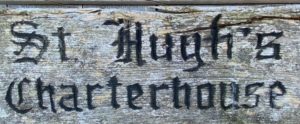
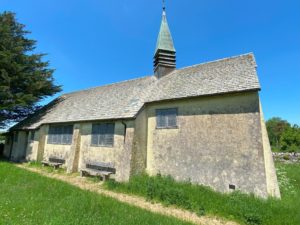

Me in the churchyard, marvelling at the Cross of St Hugh.
Our final port of call was Velvet Bottom.
“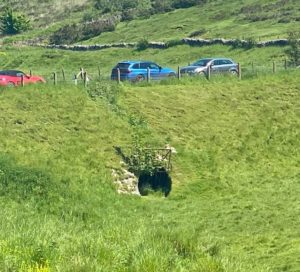 I want to see the tunnel!” I demanded, full second childhood in place.
I want to see the tunnel!” I demanded, full second childhood in place.
Then I saw it, but it was so much smaller than in my memory, I could only just make it out
I don’t think it was ever possible to go far inside.
Of all the walks I went on with Lewis Wilshire, Velvet Bottom was an icon. The one I returned to most. It was not arduous, you could have played snooker on the greensward underfoot, and so spongey, pure pleasure to walk on.
I was content then to watch the rabbits or just muse. Years later after I met George, we went back by car (!), luxury, and then again with our three infants who played among “the gruffy grounds” of lead spelter. Blocks of this material were once imported to Brislington to make our famous 18th century “Black Castle”, (otherwise “The Devil’s Cathedral”, hidden away in Sainsbury’s car park. We sure do know how to advertise our tourist attractions!) We collected small fossils like miniature washers which we never identified. Years later still, we were there with a tiny grandchild, (now a sixteen-year-old minx) who toddled gamely all the way to Black Rock but sat down on the grass and grizzled hard until picked up and carried all the way back by her Dad.
It was an industrial landscape, but I thought nothing of it when I was young. I could never have suspected then that mines and miners would play a significant part in my life: an adventure waiting for a future time. [2]
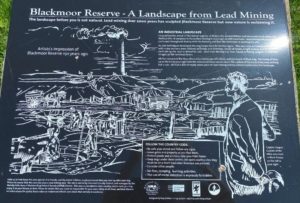
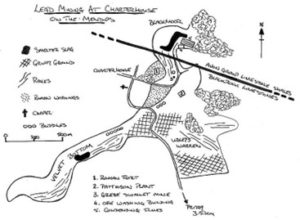
The photograph from the on-site notice board was taken by Kevin Lindegaard & the sketch filched from an article, an O.U. Geo. Weekend to Charterhouse Lead Mines, 2011, led by Peter Hardy with words and pictures by Chris Popham. My grateful thanks to all concerned.[3] I wish I could have been on the trip.
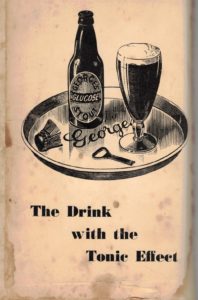 When the winter winds howled, and the snow fell in copious amounts, I would read the walks over and over. Now, I notice the quaintness of the adverts addressed to long-ago campers, ramblers, cyclists, canoeists and birdwatchers. What about Angling, in the dark, mysterious, waters of the Somerset Lake District? “Boat with Ghillie, 30 shillings; without Ghillie, 17s.6d.” Every woman should have a Ghillie. I do. George is mine.
When the winter winds howled, and the snow fell in copious amounts, I would read the walks over and over. Now, I notice the quaintness of the adverts addressed to long-ago campers, ramblers, cyclists, canoeists and birdwatchers. What about Angling, in the dark, mysterious, waters of the Somerset Lake District? “Boat with Ghillie, 30 shillings; without Ghillie, 17s.6d.” Every woman should have a Ghillie. I do. George is mine.
Clothes rationing had ceased in 1949. By 1954 limited “Sportswear” had just started coming in. Joseph Bryant Ltd offered “Everything for the Outdoor Man”. Ouch. I always wore Jeans, carried what Bryants’ called a “Rucsack” and was a member of the YHA. Naturally. COWM’s adverts were still a little shy, happier with bikes, cameras, binocs., even sporting guns. Andersons of High Street offered Plastic Macs, no Gortex then, the no nonsense “Norton” for men, “seams electronically welded”, in manly Smoke Grey, (19/11d, the retailer’s wheeze, just a penny short of a pound, which continues as 99p!). But credit where credit’s due, they did include females, the dainty but serviceable “Ella”, in pastel shades, (18/11d), or the high maintenance “Linda”, in her Raglan sleeves, Red, Grey and White Spots, with hat to march, 31/6d. The romantic swain could even have brought an engagement ring with him from Pleasance & Harper, (free insurance for a twelvemonth) with the celebration to follow via (Bristol’s Own – no relation) “George’s Glucose Stout” – the Drink with the Tonic Effect”.
It surprised me to know that that Lewis Wilshire, was a Kingswood man, born in 1914, who lived until 2006. I could have known him. In addition to “the walks” he wrote novels and stories in our unique vernacular. I wish I had thought to seek him out. I could have said “Thank You”.
[1] https://www.ubss.org.uk/resources/proceedings/vol20/UBSS_Proc_20_1_43-58.pdf
[2] “Killed in a Coalpit II – the Lives of the Somerset Colliers” by D.P. Lindegaard (which includes lead miners) is now available. Contact sgmrg.co.uk for details.
[3] https://ougs.org/southwest/event-reports/216/charterhouse-lead-mines/


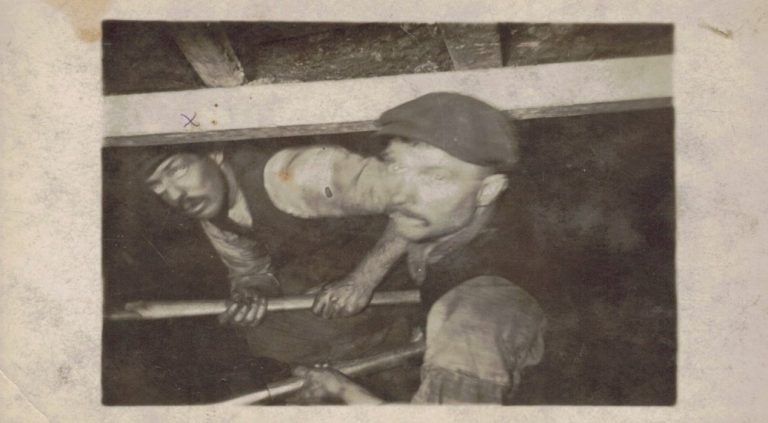
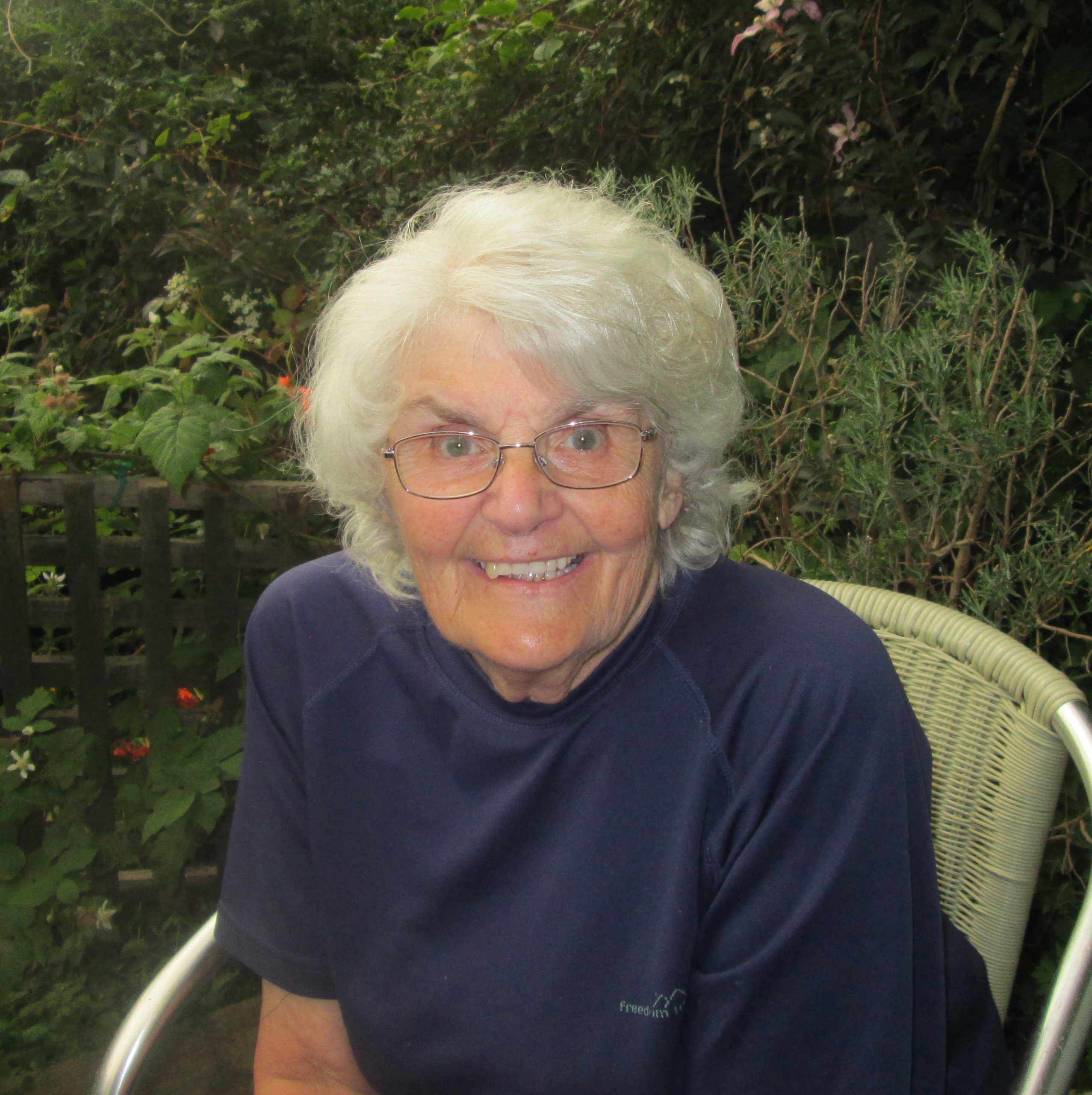




Leave a Comment